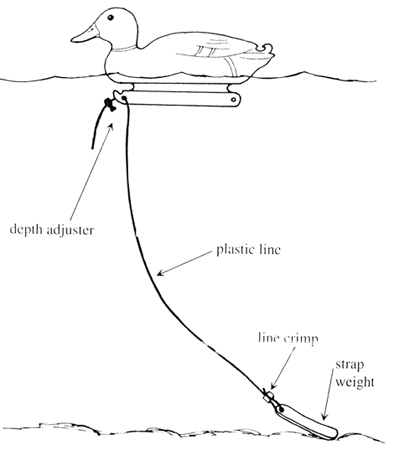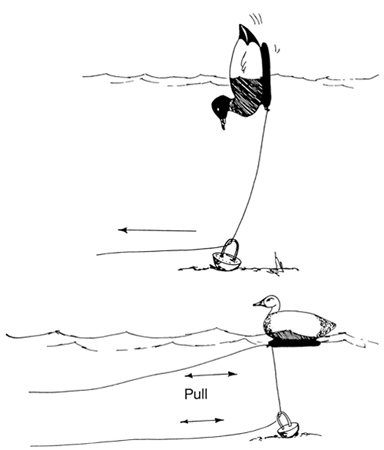Simplified Single Rigging
 To rig single decoys, simply fasten the line to the weights, and then fasten the line to the decoys, and throw them out. Most decoys have holes in both ends of the keel. I like to tie two out of each dozen in the back hole so all the decoys don’t face in the same direction, adding more variety to the spread. Ideally, the string should be long enough to allow the decoys to swing a little in the wind and waves, but not overly long or the decoys will swing around each other, again entangling the strings. A string that is too short, however, can pull up the anchors in high wind or waves. The line should be about two and a half times the water depth. For example, in 2 feet of water, a line length of 7 feet is about right. Bad weather and rising tides can increase water depth, so you need to be ready for those problems as well. Chasing rigs that have broken away in high winds and rough water is no fun — as I’ve discovered more than once.
To rig single decoys, simply fasten the line to the weights, and then fasten the line to the decoys, and throw them out. Most decoys have holes in both ends of the keel. I like to tie two out of each dozen in the back hole so all the decoys don’t face in the same direction, adding more variety to the spread. Ideally, the string should be long enough to allow the decoys to swing a little in the wind and waves, but not overly long or the decoys will swing around each other, again entangling the strings. A string that is too short, however, can pull up the anchors in high wind or waves. The line should be about two and a half times the water depth. For example, in 2 feet of water, a line length of 7 feet is about right. Bad weather and rising tides can increase water depth, so you need to be ready for those problems as well. Chasing rigs that have broken away in high winds and rough water is no fun — as I’ve discovered more than once.
The big problem is decoy string lengths must vary according to water depth. Even if you hunt the same water all the time, there will usually be some depth variation. The strings should be cut and tied at the longest length of working depth you expect to encounter. You can shorten the decoy strings by simply unwinding only the amount of line needed, then tying a loop knot around the keel protrusion on the front of the decoy. When cutting cord lengths, cut an experimental length and tie off to the decoy and weight. Adjust the length until the weight will fit snugly in place over the head or to the keel when all line is wound in place.
A couple of years ago I came up with a very simple method of using the Greenhead Gear line and cord locks. Simply thread the line through the decoy hole and place the cord lock on the loose end of the line. All you have to do to adjust the line depth is slide the line through the cord lock. The loose line falls down out of the way and also won’t tangle in the decoy bag.
An alternative method utilizes the Wing and Legs Decoy Spreader Rig from Bass Pro Shops Redhead division. The rig consists of a spreader that holds a dozen decoys. Simply attach your decoys to the spreader and put them out in the water. It’s the fastest and easiest method of putting out decoys I’ve ever tried. You can put out a dozen decoys in less than a minute. A single line and weight holds the rig in place.
Gang Rigging Made Easy

Most puddle duck sets consist of decoys rigged individually. Diver sets can, however, utilize multiple or gang-rigged sets. Gang rigged sets are also best for heavy current situations, such as those encountered when hunting rivers. Gang sets consists of one line to which several decoys are attached. Several advantages are offered for deep-water diver sets with this technique. The most important advantage is only one or two anchors are used, instead of multiple anchor lines. This prevents tangles of decoys on the long lines. This also means less time setting and pulling decoys. I use the gang, sometimes called “mother rigs” or “long lines,” in combination with individual decoys when setting combination puddler/diver sets in open water. A gang rig consists of a heavy decoy line. I like to tie an overhand loop to position each decoy on the line. A clip is fastened to the decoy and the decoy simply clipped to the loop. In the past I’ve used large fishing snap swivels and curtain hooks, and once I even took apart a metal fish stringer to get clips. If you want to provide more concealment to the main or mother line, tie a foot of dropper line to the decoy line hole, then add the snap hook.
Manufactured rigs are also available. Cabela’s offers a gang-rigging kit consisting of 28 feet of 1/8-inch black polyethylene line with built-in polyurethane stops spaced four feet apart. The decoys are attached to heavy-duty brass swivels. Cabela’s also offers a larger version with 100 feet of 300 pound-test nylon cord and 12 stainless-steel spring-loaded decoy anchor clips.
Greenhead Gear has their Quicksnap Gang Rig Clips, which solve the clip problem quite easily. You can make up your own rig easily.
Because my gang rigs are positioned out ahead of the regular set, I normally use at least 100 feet of line per dozen decoys. The rig can consist of an anchor on one end, or an anchor on each end. The former is set by anchoring into the wind and allowing the line to sway back and forth with the wind and waves. Anchoring both ends prevents entanglement, but does not provide the motion and is not quite as natural. I use discarded window sash weights for gang-line weights.
Motion Decoys
 Motion decoys are not new. In fact, they’ve been around for many years. The traditional method utilizes a decoy on a string controlled from the blind. These decoys can add a lot of action to a lifeless spread, especially on those calm, windless days. Almost any type of floater decoy can be used for the tactic, but water or hollow-keel decoys are not quite as effective as weighted keel. Two types of motion decoys can be created — the feeder and swimmer. The feeder decoy can have the line attached to either the front of the keel or the bill of the decoy. The line is run through the hole in a heavy weight. Jerking on the string causes the decoy’s head to bob underwater. A swimming decoy utilizes two lines; one to pull the decoy to you and one to allow the decoy to swim back to the anchor location. I also use the sash weights for these decoys as well.
Motion decoys are not new. In fact, they’ve been around for many years. The traditional method utilizes a decoy on a string controlled from the blind. These decoys can add a lot of action to a lifeless spread, especially on those calm, windless days. Almost any type of floater decoy can be used for the tactic, but water or hollow-keel decoys are not quite as effective as weighted keel. Two types of motion decoys can be created — the feeder and swimmer. The feeder decoy can have the line attached to either the front of the keel or the bill of the decoy. The line is run through the hole in a heavy weight. Jerking on the string causes the decoy’s head to bob underwater. A swimming decoy utilizes two lines; one to pull the decoy to you and one to allow the decoy to swim back to the anchor location. I also use the sash weights for these decoys as well.
The 4-Decoy Mallard Machine provides a great deal of action to four decoys. It consists of a 12-volt system that creates a variety of motions, including diving, bobbing, swimming or thrashing. It also comes with a remote control. The Wings and Legs Jerk-A-Spreader, from Bass Pro Shops, allows you to move a dozen decoys all at once. It comes with a four-foot stake, a bungee cord and 60 feet of tar-coated string and swivels. Another type of motion decoy is the Quiver Magnet H20. This is simply a tiny round “puck” that floats on the water and quivers to add water motion. It’s very economical and effective.
Probably the ultimate motion decoy is the Ultimate Swim’n Duck or Swim’n Goose from Ultimate Hunter. They can bring a lot of motion to your decoy set in a hurry. These are remote controlled decoys with a natural swimming action. They go forward, backward, turn right or left and are excellent for windless days. Their operating range is 30 yards and they are available in Canada and snow goose, mallard, pintail, wood duck and widgeon drake and hen designs. But be forewarned, you may have so much fun running your decoy you forget to shoot.
Try these easy-does-it rigs on your decoy sets this season. You’ll find setting out and pulling decoys is no longer the frustrating chore it used to be.








































![Air gun 101: The differences between .177 & .22 – Which jobs they do best ? [Infographic]](https://airgunmaniac.com/wp-content/uploads/2020/09/g44-150x150.jpg)


